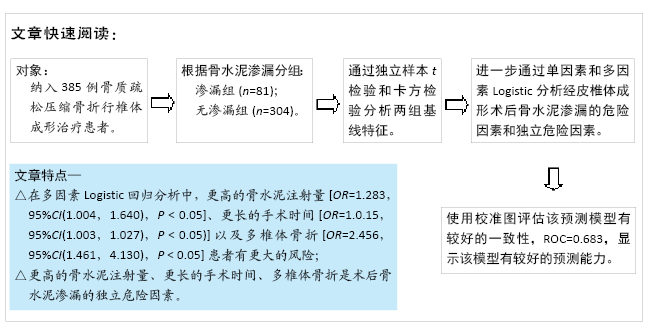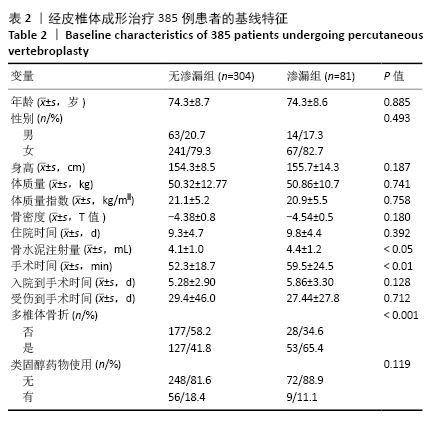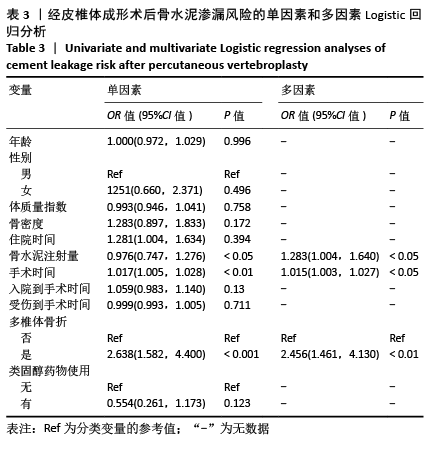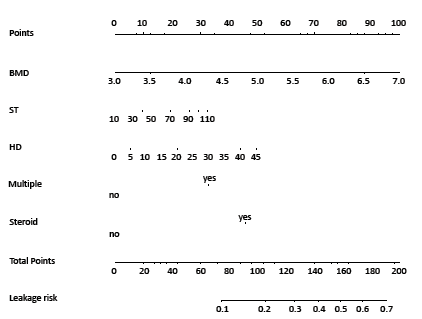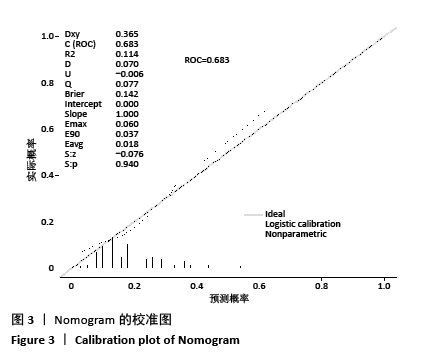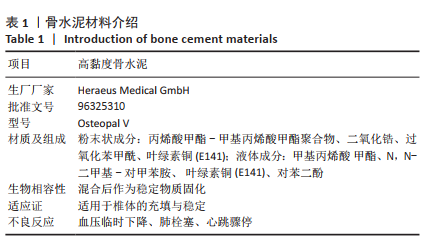[1] JOHNELL O, KANIS JA. An estimate of the worldwide prevalence and disability associated with osteoporotic fractures. Osteoporos Int. 2006; 17(12):1726.
[2] LAVELLE W, CARL A, LAVELLE ED, et al. Vertebroplasty and Kyphoplasty. Med Clin North Am. 2007;25(2):913-928.
[3] YANG EZ, XU JG, HUANG GZ, et al. Percutaneous Vertebroplasty Versus Conservative Treatment in Aged Patients With Acute Osteoporotic Vertebral Compression Fractures: A Prospective Randomized Controlled Clinical Study. Spine. 2016;41(8):653.
[4] KLAZEN CA, LOHLE PN, DE VRIES J, et al. Vertebroplasty versus conservative treatment in acute osteoporotic vertebral compression fractures (Vertos II): an open-label randomised trial. Lancet. 2010; 376(9746):1085-1092.
[5] CHANG W, ZHANG X, JIAO N, et al. Unilateral versus bilateral percutaneous kyphoplasty for osteoporotic vertebral compression fractures: A meta-analysis. Bone Joint J. 2014;96(17):e6738.
[6] SCHMIDT R, CAKIR B, MATTES T, et al. Cement leakage during vertebroplasty: an underestimated problem? Eur Spine J. 2005;14(5): 466-473.
[7] HULME PA, KREBS J, FERGUSON SJ, et al. Vertebroplasty and kyphoplasty: a systematic review of 69 clinical studies. Spine (Phila Pa 1976). 2006;31(17):1983-2001.
[8] CLARK W, BIRD P, GONSKI P, et al. Safety and efficacy of vertebroplasty for acute painful osteoporotic fractures (VAPOUR): a multicentre, randomised, double-blind, placebo-controlled trial. Lancet (London, England). 2016;388(10052):1408-1416.
[9] RHO YJ, CHOE WJ, CHUN YI. Risk factors predicting the new symptomatic vertebral compression fractures after percutaneous vertebroplasty or kyphoplasty. Eur Spine J. 2012;21(5):905-911.
[10] CHEN Z, CHEN Z, WU Y, et al. Risk Factors of Secondary Vertebral Compression Fracture After Percutaneous Vertebroplasty or Kyphoplasty: A Retrospective Study of 650 Patients. Med Sci Monit. 2019;25:9255-9261.
[11] LIN EP, EKHOLM S, HIWATASHI A, et al. Vertebroplasty: Cement Leakage into the Disc Increases the Risk of New Fracture of Adjacent Vertebral Body. AJNR Am J Neuroradiol. 2004;25(2):175-180.
[12] AHN Y, LEE JH, LEE HY, et al. Predictive factors for subsequent vertebral fracture after percutaneous vertebroplasty. J Neurosurg Spine. 2008; (2):129-136.
[13] CHEN WJ, KAO YH, YANG SC, et al. Impact of cement leakage into disks on the development of adjacent vertebral compression fractures. N Engl J Med. 2010;23(1):35-39.
[14] XIE W, JIN D, MA H, et al. Cement Leakage in Percutaneous Vertebral Augmentation for Osteoporotic Vertebral Compression Fractures: Analysis of Risk Factors. Clin Spine Surg. 2016;29(4):E171.
[15] NIEUWENHUIJSE MJ, PUTTER H, VAN ERKEL AR, et al. New vertebral fractures after percutaneous vertebroplasty for painful osteoporotic vertebral compression fractures: a clustered analysis and the relevance of intradiskal cement leakage. Radiology. 2013;266(3):862-870.
[16] LEE DG, PARK CK, PARK CJ, et al. Analysis of Risk Factors Causing New Symptomatic Vertebral Compression Fractures After Percutaneous Vertebroplasty for Painful Osteoporotic Vertebral Compression Fractures. J Spinal Disord Tech. 2015;28(10):E578.
[17] PARK SY. Nomogram: An analogue tool to deliver digital knowledge. J Thorac Cardiovasc Surg. 2018;155(4):1793.
[18] GALIBERT P, DERAMOND H, ROSAT P, et al. Preliminary note on the treatment of vertebral angioma by percutaneous acrylic vertebroplasty. Neurochirurgie. 1987;33(2):166-168.
[19] FILIPPIADIS DK, MARCIA S, MASALA S, et al. Percutaneous Vertebroplasty and Kyphoplasty: Current Status, New Developments and Old Controversies. Cardiovasc Intervent Radiol. 2017;40(12): 1815-1823.
[20] BUCHBINDER R, KALLMES DF, JARVIK JG, et al. Conduct and reporting of a vertebroplasty trial warrants critical examination. Evid Based Med. 2017;22(3):106-107.
[21] VOORMOLEN MH, LOHLE PN, JUTTMANN JR, et al. The risk of new osteoporotic vertebral compression fractures in the year after percutaneous vertebroplasty. J Vasc Interv Radiol. 2006;17(1):71-76.
[22] HAN S, JANG IT. Analysis of Adjacent Fractures after Two-Level Percutaneous Vertebroplasty: Is the Intervening Vertebral Body Prone to Re-fracture? Asian Spine J. 2018;12(3):524-532.
[23] CAROLINE AHK. Vertebroplasty versus conservative treatment in acute osteoporotic vertebral compression fractures (Vertos II): an open-label randomised trial. Lancet (London, England). 2010;9746:376.
[24] HARRINGTON KD. Major neurological complications following percutaneous vertebroplasty with polymethylmethacrylate : a case report. J Bone Joint Surg Am. 2001;84(7):1070-1073.
[25] REN HL, JIANG JM, CHEN JT, et al. Risk factors of new symptomatic vertebral compression fractures in osteoporotic patients undergone percutaneous vertebroplasty. Eur Spine J. 2015;24(4):750-758.
[26] FU Z, HU X, WU Y, et al. Is There a Dose–Response Relationship of Cement Volume With Cement Leakage and Pain Relief After Vertebroplasty? Dose Response. 2016;14(4):1559325816682867.
[27] ZHAN Y, JIANG J, LIAO H, et al. Risk Factors for Cement Leakage After Vertebroplasty or Kyphoplasty: A Meta-Analysis of Published Evidence. World Neurosurgery. 2017;101:633-642.
[28] ZHU SY, ZHONG ZM, WU Q, et al. Risk factors for bone cement leakage in percutaneous vertebroplasty: a retrospective study of four hundred and eighty five patients. Int Orthop. 2016;40(6):1205-1210.
[29] HA KY, LEE JS, KIM KW, et al. Percutaneous vertebroplasty for vertebral compression fractures with and without intravertebral clefts. J Bone Joint Surg Br. 2006;88(5):629-633.
[30] LIU Q, CAO J, KONG JJ. Clinical effect of balloon kyphoplasty in elderly patients with multiple osteoporotic vertebral fracture. Niger J Clin Pract. 2019;22(3):289-292.
[31] CHUNG SM, MOON JS, YOON JS, et al. Novel Nomogram for Screening the Risk of Developing Diabetes in a Korean Population. Diabetes Res Clin Pract. 2018;142:286-293.
[32] VEALE D, MILES S, BRAMLEY S, et al. Am I normal? A systematic review and construction of nomograms for flaccid and erect penis length and circumference in up to 15,521 men. BJU Int. 2015;115(6): 978-986. |
